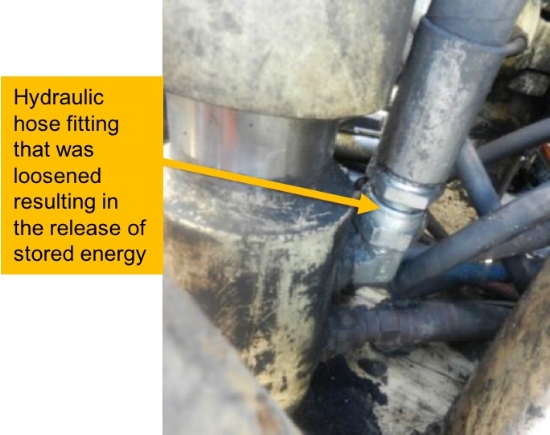Release of Stored Energy: Fatality and Permanent Disabilities
Summary written by Colin Rice
Two identical accidents, one resulting in a fatality and another resulting in permanent disabilities to two people. The lesson should have been shared and therefore the second accident should have been prevented!
When DrillSafe was launched in 2013, the original objective was to share, as widely as possible, the learnings from accidents and incidents. Unfortunately, we found that many mining companies were reluctant to share information and therefore the DrillSafe model changed. What has remained the same however, is the importance we place on sharing information with the aim of preventing repeated accidents and incidents. These two almost identical accidents illustrate very clearly how important it is for us to share information.
Accident 1: Blasthole drill accident - 2012
This is an extract of the findings of a preliminary investigation into a serious accident that took place on a blasthole drill rig in 2012.
The maintenance fitter had completed his daily checks on the drill and was repairing an oil leak on the left-hand side feed cylinder of the drill. A mechanic was observing what the fitter was doing as he was being coached on the workings and maintenance aspects of the drill.
Drilling terms
The fitter requested that the drill operator raise the rotation head, drillpipe and drill bit high into the mast to allow him better access to the leaking hose fitting. The fitter took up a kneeling position with his right leg over the opening in the drill deck through which the drill string passes during drilling operations.
Fitter’s leg position prior to the accident – simulated with a mannequin
The fitter loosened the hydraulic hose fitting on the feed cylinder. This resulted in the loss of hydraulic fluid from within the cylinder and resulted in the rotation head and drillstring plunging downwards through the drill deck amputating the right leg of the fitter below the knee.
Hydraulic hose fitting on feed cylinder
The mechanic had taken up a position on the right-hand side of the fitter. The mechanic was holding on to the steel wire pulldown rope and when the rotation head and drillstring fell downwards, the mechanic’s right hand was pulled through the sheave wheel resulting in the amputation of four fingers and thumb.
Accident 2: Blasthole drill accident - 2017
Two employees were replacing the regenerative (regen) valve on a drill rig’s rotational drill head assembly. A regen valve allows quicker vertical movement of the drill head when not under heavy load. The faulty regen valve resulted in the drill head being stuck in the upper third of the drill mast.
The two employees started to disconnect the hydraulic hoses from the regen valve. While attempting to remove the valve, one employee noticed the valve body was attached to a plate with bolts that were connected on the inside of the mast. He then went inside the mast and attempted to climb up the lower portion of the mast to remove the bolts.
The removal of the hydraulic lines to the regen valve resulted in pressure being released from the lower hydraulic cylinder line, enabling the drill head to fall. As he was inside the mast, the rotary head that was falling struck him.
He cried out and the other employees noticed the rotary head had struck his upper back and that he was pinned between the rotary head and the frame of the mast.
A boom truck was used to raise the rotary head and the emergency response system was activated. An ambulance arrived on the scene and he was removed from the drill and taken to a medical treatment facility.
Attempts to resuscitate him were unsuccessful.
So – two identical accidents – one resulting in a fatality and one resulting in permanent disabilities to two people.
It is pretty clear from the summaries above that the artisans working on the drills had little knowledge of the workings of a drill rig and even less appreciation for the concept of stored energy. There is no doubt that the employers in both cases did a pretty poor job of ensuring that their employees were competent to carry out their duties. There is no doubt that the artisans in question were all trained – but, as I have always argued, there is a world of difference between being trained and being competent.
Both of these accidents were on blasthole drills, not exploration drills but this only serves to demonstrate that all drilling methods and machines are hazardous and a clear understanding of the hazards associated with a drilling operation are essential - even for mine engineers.
These two accidents tragically demonstrate why DrillSafe is such an important initiative –
We have to improve the level of understanding of drill site hazards and,
We have to share learnings from accidents and incidents.
If you believe that anyone in your organisation can benefit from DrillSafe then please ensure that they sign up and become part of the DrillSafe community.
Read the details of the 2017 Blasthole Drill fatality in this report published by the Australian Drilling Industry Association.


